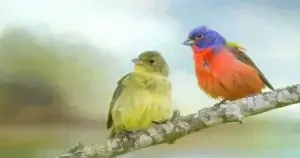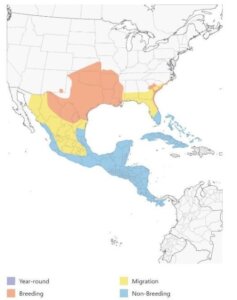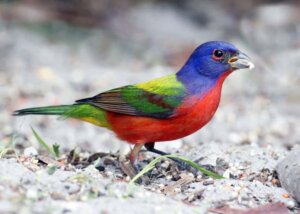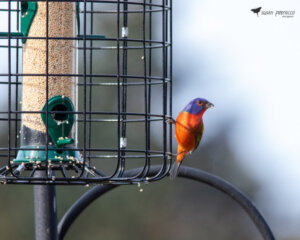Do Painted Buntings Migrate?: Unveiling Their Seasonal Journey
Yes, Painted Buntings do migrate. These colorful birds travel between their breeding and wintering grounds.
They move southward in late summer and return north in spring. Painted Buntings are a sight to behold. Their vibrant colors make them a favorite among bird watchers. But, there’s more to these birds than their beauty. Migration is a key part of their life cycle.
Understanding their migration patterns helps us protect them. This blog will explore why they migrate and where they go. Stay with us to learn more about these fascinating birds and their incredible journeys.
Introduction To Painted Buntings
The Painted Bunting is a vibrant and colorful bird. It is often called a “nonpareil,” meaning “without equal,” due to its stunning appearance. These birds are a favorite among bird watchers and nature enthusiasts.
Description And Habitat
The male Painted Bunting is known for its bright blue, green, red, and yellow plumage. Females and juveniles, on the other hand, sport a more subdued green and yellow coloring. These birds are small, measuring about 5.5 inches in length.
Painted Buntings prefer to live in thickets, woodland edges, and brushy areas. They often nest in low shrubs and dense foliage. Their preferred habitat provides ample cover and food sources, such as seeds and insects.
Population Distribution
Painted Buntings are primarily found in the southeastern United States. Their range extends from Texas to Florida and up to North Carolina. During the breeding season, they can also be found in parts of northern Mexico.
In winter, Painted Buntings migrate to warmer climates. They travel to Central America, the Bahamas, and southern Florida. This migration helps them find food and suitable habitat during the colder months.
| Region | Season |
|---|---|
| Southeastern United States | Breeding |
| Central America, Bahamas, Southern Florida | Winter |
The Painted Bunting’s migration patterns are vital for their survival. Understanding these patterns helps in conserving their habitats and ensuring their populations remain healthy.

Credit: www.youtube.com
Migration Patterns
Painted Buntings migrate to Central America and the Caribbean during winter. These colorful birds travel long distances to escape the cold. They return to the southern United States to breed in summer.
Painted Buntings are small, colorful birds that capture the imagination. Their migration patterns are fascinating. Understanding these patterns helps us appreciate these vibrant creatures. Let’s delve into their seasonal movements and geographical routes.
Seasonal Movements
Painted Buntings migrate to find suitable climates and food sources. During spring, they travel north to their breeding grounds. These areas include parts of the United States, like Texas and Florida. In the fall, they head south to warmer regions. This includes Mexico, Central America, and the Caribbean. The timing of these movements is crucial for their survival.
Geographical Routes
The routes Painted Buntings take during migration are well-defined. Many follow the Gulf Coast to reach their destinations. Some fly over land, while others cross the Gulf of Mexico. These routes ensure they find enough food and safe resting spots. The migration journey can be long and challenging. Yet, these birds navigate it with remarkable accuracy.
“`
Factors Influencing Migration
Painted Buntings are known for their migration patterns. These small, colorful birds travel long distances. Various factors influence their migration. Understanding these factors helps us appreciate their journey.
Climate And Weather
Climate and weather play a crucial role in migration. Painted Buntings migrate to find suitable climates. During winter, they move to warmer regions. They seek areas with mild temperatures and less harsh weather. Climate change also impacts their migration. Unpredictable weather patterns can alter their routes.
Food Availability
Food availability is another key factor. Painted Buntings migrate to find abundant food sources. They need seeds, insects, and berries for survival. During breeding season, they require more food. If food is scarce, they travel further. This need for nourishment drives their long journeys.
Tracking Techniques
Tracking Techniques are essential to understand the migration patterns of Painted Buntings. By employing various methods, researchers can gather valuable data on these colorful songbirds. Let’s explore some of the key techniques used by ornithologists.
Banding And Tagging
Banding and tagging are traditional methods used to track Painted Buntings. Researchers catch the birds and place a small, lightweight band around their leg. Each band has a unique code that helps identify the bird.
This method allows researchers to gather important data, such as:
- Movement patterns
- Lifespan
- Reproductive success
While simple, banding requires capturing the bird multiple times to collect data. This can be challenging and time-consuming.
Satellite Tracking
Satellite tracking uses advanced technology to monitor Painted Buntings. Tiny transmitters are attached to the birds, which then send signals to satellites. This method provides real-time data on their location and movement.
Some key benefits of satellite tracking include:
- Tracking long-distance migration
- Gathering data without recapturing the birds
- Identifying critical habitats
Although more expensive, satellite tracking offers comprehensive insights into the migration patterns of Painted Buntings.
Challenges During Migration
Painted Buntings face many challenges during migration. These small, colorful birds travel long distances each year. During their journey, they encounter various obstacles. Let’s explore some of these challenges.
Predators And Threats
Predators are a significant threat during migration. Hawks, owls, and other birds of prey hunt Painted Buntings. These predators can easily spot them because of their bright colors.
Snakes and mammals also pose a danger. They often target nests and young birds. Painted Buntings must stay alert to avoid these threats.
Human Interference
Human activities create many challenges for Painted Buntings. Urbanization leads to habitat loss. As cities expand, these birds lose their natural homes. This forces them to find new places to live.
Light pollution is another issue. Bright city lights confuse migrating birds. They may fly off course or become exhausted. This makes their journey more difficult.
Collisions with buildings and vehicles are common. Many birds die each year from these accidents. This reduces their population and makes migration even harder.
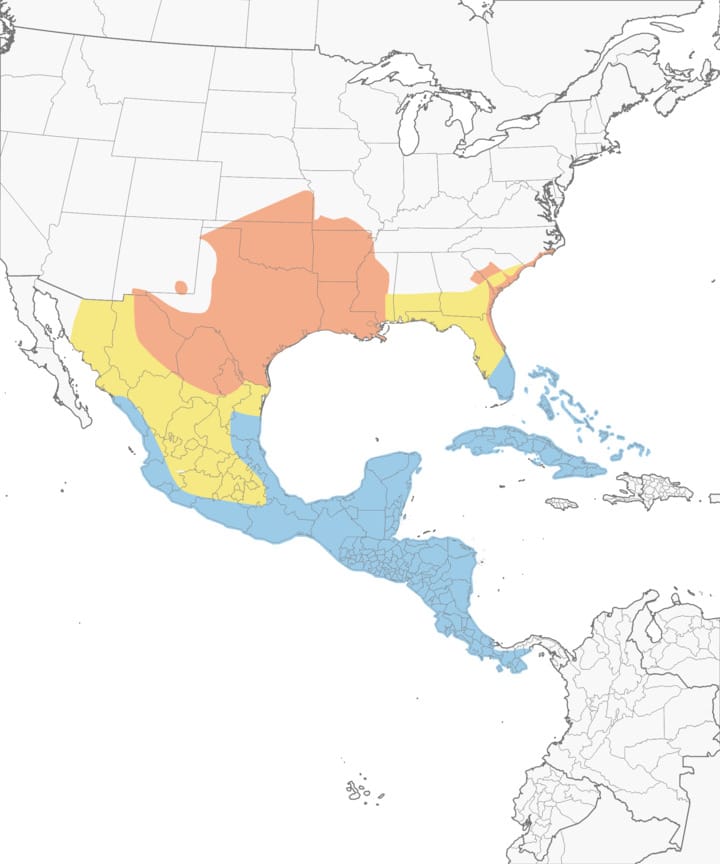
Credit: www.allaboutbirds.org
Conservation Efforts
Conservation efforts for Painted Buntings are crucial. These vibrant birds face many challenges. People must act to protect their habitats. Scientists also need to understand their behaviors better. Let’s explore some key areas of focus.
Habitat Protection
Habitat protection is vital for Painted Buntings. Loss of habitat is a major threat. Urban development and farming reduce their living spaces. Conservationists work to preserve natural areas. They create safe zones where buntings can thrive.
Planting native plants helps. These plants provide food and shelter. Conservation groups also restore damaged habitats. This work supports the birds’ survival. Public awareness campaigns educate people. More people then support habitat protection.
Research And Monitoring
Research and monitoring are key to conservation. Scientists study the birds’ migration patterns. They track where Painted Buntings travel. This data helps create effective conservation plans.
Bird banding is one method used. Researchers attach small bands to birds’ legs. These bands help track their movements. Satellite tracking is another tool. It provides detailed information on migration routes.
Monitoring also involves counting bird populations. This helps assess if conservation efforts work. Volunteers often assist with these counts. Their help is valuable for gathering data.
Conservationists use the data collected. They adjust strategies based on findings. This ensures the best outcomes for Painted Buntings.
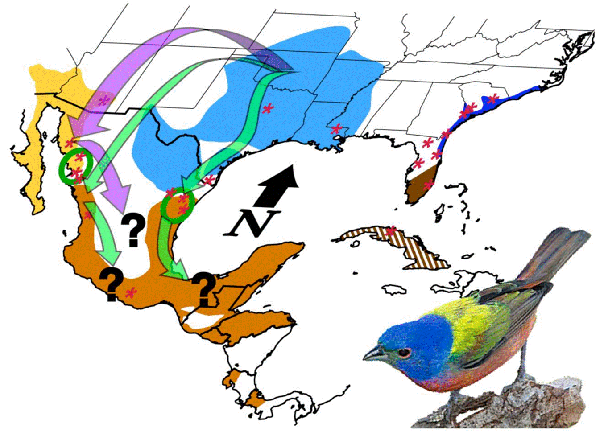
Credit: animalmigration.org
Frequently Asked Questions
Do Painted Buntings Migrate In Winter?
Yes, Painted Buntings migrate in winter. They move from the United States to Central America and the Caribbean.
Where Do Painted Buntings Go During Migration?
During migration, Painted Buntings travel to Mexico, Central America, and the Caribbean islands for the winter season.
When Do Painted Buntings Start Migrating?
Painted Buntings typically start their migration in late summer or early fall, usually around September.
How Far Do Painted Buntings Migrate?
Painted Buntings can migrate up to 1,000 miles. They travel from the southeastern United States to Central America.
Conclusion
Painted Buntings are fascinating birds with a unique migration pattern. They travel thousands of miles each year. This journey ensures their survival through changing seasons. Understanding their migration helps bird watchers and nature lovers. Protecting their habitats is crucial for their future.
So, next time you see a Painted Bunting, remember their incredible journey. Keep learning about these beautiful birds and help preserve their environment. Every small effort counts in conserving wildlife. Happy bird watching!
Hello Dear, I'm Poli Kolymnia, owner of many birds (including budgies).
With a deep passion for these feathered companions, I'm here to share my expertise and extensive knowledge on birds care.
My articles cover essential topics like diet, housing, care, and health, providing practical tips to help you create a happy and thriving environment for your birds.


